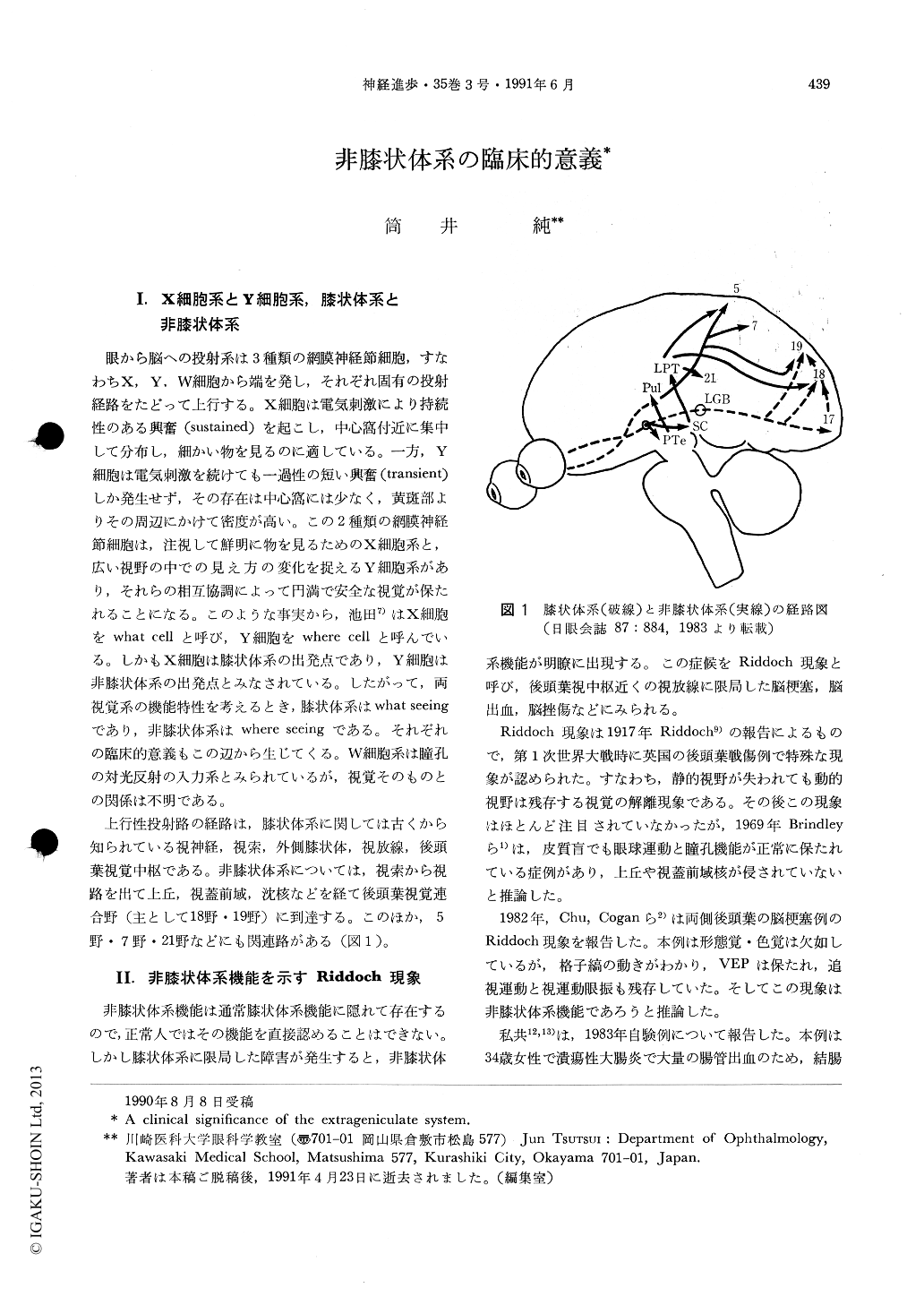Japanese
English
- 有料閲覧
- Abstract 文献概要
- 1ページ目 Look Inside
I.X細胞系とY細胞系,膝状体系と非膝状体系
眼から脳への投射系は3種類の網膜神経節細胞,すなわちX,Y,W細胞から端を発し,それぞれ固有の投射経路をたどって上行する。X細胞は電気刺激により持続性のある興奮(sustained)を起こし,中心窩付近に集中して分布し,細かい物を見るのに適している。一方,Y細胞は電気刺激を続けても一過性の短い興奮(transient)しか発生せず,その存在は中心窩には少なく,黄斑部よりその周辺にかけて密度が高い。この2種類の網膜神経節細胞は,注視して鮮明に物を見るためのX細胞系と,広い視野の中での見え方の変化を捉えるY細胞系があり,それらの相互協調によって円満で安全な視覚が保たれることになる。このような事実から,池田7)はX細胞をwhat cellと呼び,Y細胞をwhere cellと呼んでいる。しかもX細胞は膝状体系の出発点であり,Y細胞は非膝状体系の出発点とみなされている。したがって,両視覚系の機能特性を考えるとき,膝状体系はwhat seeingであり,非膝状体系はwhere seeingである。それぞれの臨床的意義もこの辺から生じてくる。W細胞系は瞳孔の対光反射の入力系とみられているが,視覚そのものとの関係は不明である。
上行性投射路の経路は,膝状体系に関しては古くから知られている視神経,視索,外側膝状体,視放線,後頭葉視覚中枢である。非膝状体系については,視索から視路を出て上丘,視蓋前域,沈核などを経て後頭葉視覚連合野(主として18野・19野)に到達する。このほか,5野・7野・21野などにも関連路がある(図1)。
A clinical significance of the human extrageniculate system was investigated on a case of cortical blindness with the Riddoch's phenomenon.
A 34-year-old woman showing the Riddoch phenomenon, the dissociation of the visual perception in which one can perceive a moving object despite having the loss of form recognition. This case had cortical blindness which developed during the process of massive intestinal hemorrhage, the visual acuity was limited to hand movement and perception of white and colored light was present, but there was no form recognition. The tracking eye movement for a flashlight was possible without smoothness and optokinetic nystagmus (OKN) also preserved. CT-scan showed a diffuse low density area in the white matter of the occipital lobe but the superior colliculus and parietal cortex were preserved well. The VEPs by flash a checkerboard were detectable. Dynamic topography of the short latency VEP showed that a strong negative deflection from the brainstem appeared at around 30 msec and this deflection expanded to the parietal region at about 90 msec. Subsequently a positive deflection extending from the central region to the occipital region continued. Such a process of reaction is not observed in the normal subject. These findings suggest that the visual reaction was conducted abnormally through the extrageniculate system from the brainstem to the parietal area and then to the occipital area.

Copyright © 1991, Igaku-Shoin Ltd. All rights reserved.


